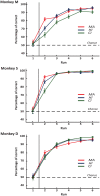Macaque monkeys learn by observation in the ghost display condition in the object-in-place task with differential reward to the observer
- PMID: 30674953
- PMCID: PMC6344553
- DOI: 10.1038/s41598-018-36803-4
Macaque monkeys learn by observation in the ghost display condition in the object-in-place task with differential reward to the observer
Abstract
Observational learning has been investigated in monkeys mainly using conspecifics or humans as models to observe. Some studies attempted to clarify the social agent's role and to test whether non-human primates could learn from observation of a non-social agent, usually mentioned as a 'ghost display' condition, but they reported conflicting results. To address this question, we trained three rhesus monkeys in an object-in-place task consisting of the presentation of five subsequent problems composed of two objects, one rewarded and one unrewarded, for six times, or runs. Three types of learning conditions were tested. In the individual learning condition, the monkeys performed the first run, learned from it and improved their performance in the following runs. In the social and non-social learning conditions, they observed respectively a human model and a computer performing the first run and learned by the observation of their successes or errors. In all three conditions, the monkeys themselves received the reward after correct choices only. One-trial learning occurred in all three conditions. The monkeys performed over chance in the second run in all conditions, providing evidence of non-social observational learning with differential reward in macaque monkeys using a "ghost display" condition in a cognitive task.
Conflict of interest statement
The authors declare no competing interests.
Figures



Similar articles
-
Model-observer similarity, error modeling and social learning in rhesus macaques.PLoS One. 2014 Feb 24;9(2):e89825. doi: 10.1371/journal.pone.0089825. eCollection 2014. PLoS One. 2014. PMID: 24587063 Free PMC article.
-
Role of the social actor during social interaction and learning in human-monkey paradigms.Neurosci Biobehav Rev. 2019 Jul;102:242-250. doi: 10.1016/j.neubiorev.2019.05.004. Epub 2019 May 6. Neurosci Biobehav Rev. 2019. PMID: 31071362 Review.
-
Macaque monkeys can learn token values from human models through vicarious reward.PLoS One. 2013;8(3):e59961. doi: 10.1371/journal.pone.0059961. Epub 2013 Mar 27. PLoS One. 2013. PMID: 23544115 Free PMC article.
-
Fornix transection impairs learning of randomly changing object discriminations.J Neurosci. 2007 Nov 21;27(47):12868-73. doi: 10.1523/JNEUROSCI.3536-07.2007. J Neurosci. 2007. PMID: 18032659 Free PMC article.
-
'Ghost' experiments and the dissection of social learning in humans and animals.Biol Rev Camb Philos Soc. 2010 Nov;85(4):685-701. doi: 10.1111/j.1469-185X.2010.00120.x. Biol Rev Camb Philos Soc. 2010. PMID: 20128784 Review.
Cited by
-
Six adult male rhesus monkeys did not learn from the choices of a conspecific shown in videos.Anim Cogn. 2023 Mar;26(2):379-392. doi: 10.1007/s10071-022-01669-7. Epub 2022 Aug 18. Anim Cogn. 2023. PMID: 35982328 Free PMC article.
-
The use of individual, social, and animated cue information by capuchin monkeys and children in a touchscreen task.Sci Rep. 2021 Jan 13;11(1):1043. doi: 10.1038/s41598-020-80221-4. Sci Rep. 2021. PMID: 33441782 Free PMC article.
-
Effects of early maternal care on adolescent attention bias to threat in nonhuman primates.Dev Cogn Neurosci. 2019 Aug;38:100643. doi: 10.1016/j.dcn.2019.100643. Epub 2019 Apr 30. Dev Cogn Neurosci. 2019. PMID: 31170549 Free PMC article.
-
Dedicated Representation of Others in the Macaque Frontal Cortex: From Action Monitoring and Prediction to Outcome Evaluation.Cereb Cortex. 2022 Feb 8;32(4):891-907. doi: 10.1093/cercor/bhab253. Cereb Cortex. 2022. PMID: 34428277 Free PMC article. Review.
-
Five Breakthroughs: A First Approximation of Brain Evolution From Early Bilaterians to Humans.Front Neuroanat. 2021 Aug 17;15:693346. doi: 10.3389/fnana.2021.693346. eCollection 2021. Front Neuroanat. 2021. PMID: 34489649 Free PMC article.
References
-
- Bandura, A. Social learning theory. Englewood Cliffs: Prentice-Hall (1977).
Publication types
MeSH terms
LinkOut - more resources
Full Text Sources

